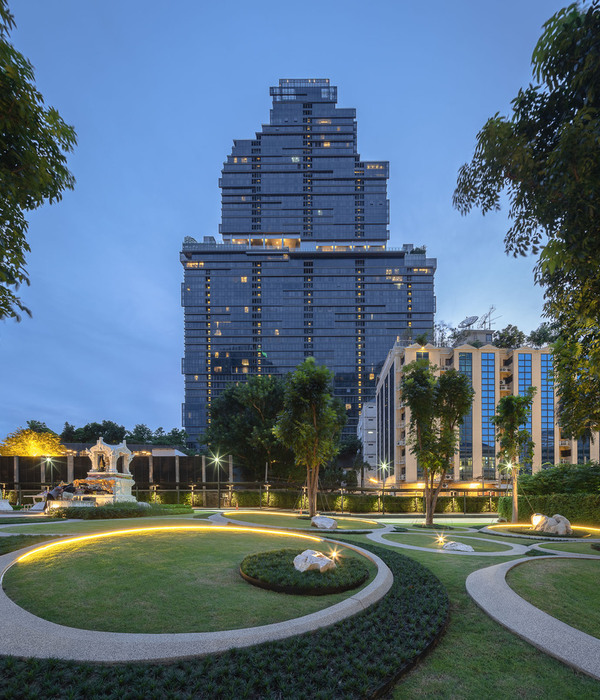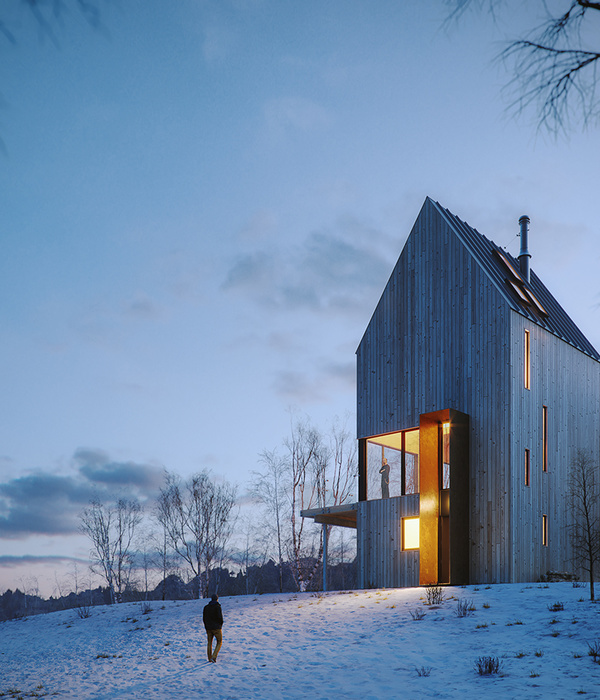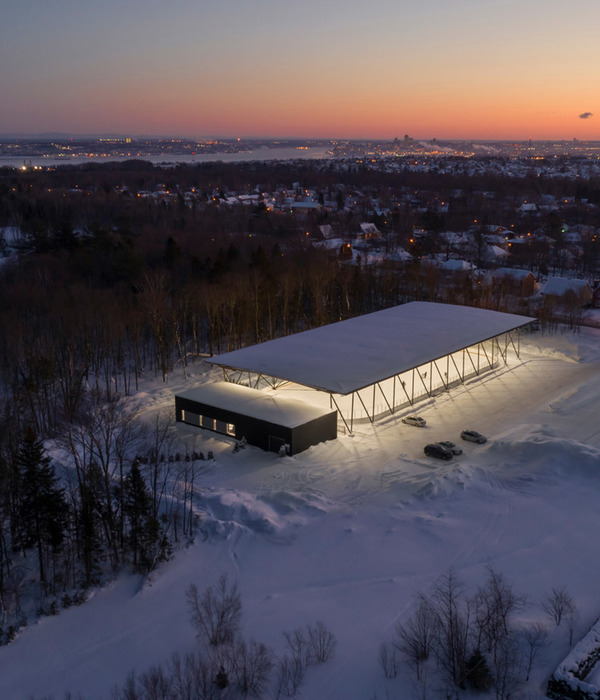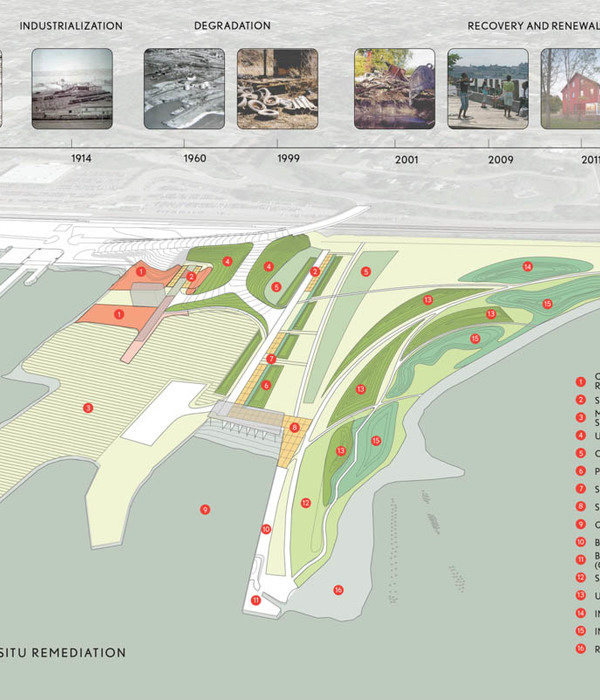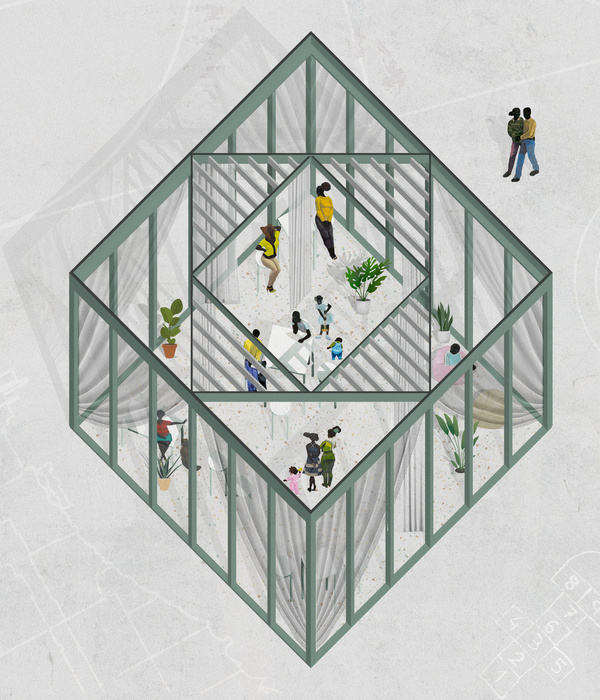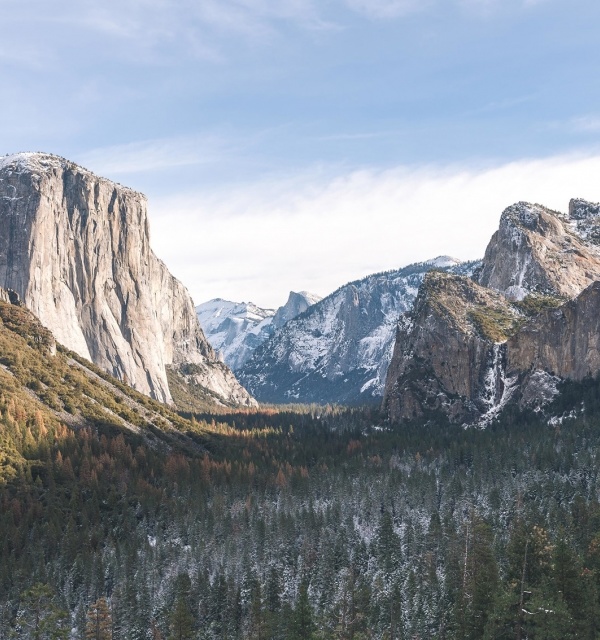乌镇谭家湾农业遗址公园步行桥与稻田书局是同期设计的,相隔不远。乌镇所处江南水乡,水网密布,谭家湾遗址内的一条水系也蜿蜒其中,规划流线便与水网交叉,于是产生了对桥的需求。但又须遵循遗址保护核心区内不可建造建筑物或构筑物的要求,于是经过不断调整,桥的选址最终定在紧贴核心区的外缘。
The pedestrian bridge of Tan Jiawan agricultural site park in Wuzhen was designed at the same time as the Rice Field Bookstore, not far away. Wuzhen is located in the south of the Yangtze River, the water network, Tan Jiawan site of a water system also winding, planning streamline and water network intersection, thus creating the need for the bridge. But we must follow the principle that buildings or structures can not be built in the site protection core area, so after constant adjustment, the site of the bridge was finally located close to the core of the outer edge.
▼鸟瞰图,aerial view © 杨建刚
▼桥面俯视,deck view © 杨建刚
这座桥可简单可复杂。在设计之初,我们把目光投向了乌镇以及设计场地。
乌镇保留着许多桥廊,其中我们感到最有意思的是逢源双桥。它位于乌镇东栅景区端头,由两座平行的桥紧挨着组成,统一在顶部的双坡屋顶下。两桥之间设置了木构屏风,人可以相互感知,但却朦胧不清,恰似《似水年华》中黄磊与刘若英扮演的男女主之间的那份情愫——相遇然后错过。
This bridge’s design can be very simple, or very complicated. At the beginning , we aimed at Wuzhen and the design site.
Wuzhen has a lot of bridges and verandas, but the most interesting one is the Fengyuan double bridge, which is located at the end of the east gate scenic area in Wuzhen. It is composed of two parallel bridges which are arranged next to each other and are unified under the double pitched roof at the top. There is a wooden screen between the two bridges, where people can sense each other, but it’s hazy, like 《The Flowing Time》between Huang Lei and René Liu in time flies — meeting and missing.
▼从河的东岸看桥,view from the east bank © 杨力维
桥是承载人活动的空间,同时又是流线的必经之处。提供一个场所,让人们以不同的方式进入空间相遇,然后发生一些故事,整个过程较为有趣。所以我们将一座桥拆分成了两座,使其错位,形成一个扭转点,促使人流在此减速、变向、相遇、停留。
The bridge is not only a place for people to move about, but also a necessary place for streamline. It’s interesting to have a place where people meet in different ways, and then something happens. So we split a bridge into two, so that its dislocation, the formation of a turning point, to slow down the flow of people here, change direction, meet, stay.
▼一座桥被拆分成了两座,the bridge was split into two © 杨建刚
▼晨曦下的桥体入口,entrance to the bridge in the morning sun © 杨建刚
▼桥的另一端,view from the other side © 杨建刚
整个谭家湾遗址地势相对平坦又以稻田景观为主,我们希望人们从平坦开阔的稻田走来,穿过树丛,登上高处,顺着开阔的水口眺看远处稻田。但受限于公园的要求,场地无供游人休憩避雨的场所,且在视觉上除了稻田书局外并无明显的标志物。因此在两个桥身结合的地方做了一座桥亭,既是远观的标志物,又可作为广阔稻田里用于定位的集合点。其结构延续了两座桥的分离感——由两座桥的交点处分别升起竖向结构,材料也区分为联排钢柱和混凝土墙,在顶端相对着悬挑出一根钢梁和混凝土梁,最终统一在一片倾斜屋面下:两座桥由此形成缠绕。
The entire Tan Jiawan site is relatively flat and dominated by paddy fields. We want people to walk from the flat and open paddy fields, walk through the trees, climb to the heights and look down the open water outlet to see the paddy fields in the distance. However, due to the requirements of the park, there is no place for visitors to rest and take shelter from the rain. Therefore, a bridge pavilion is built at the junction of the two bridges, which is not only a symbol of the distant view, but also a gathering point for positioning in the vast rice fields. The structure continues the sense of separation between the two bridges — a vertical structure is raised at the intersection of the two bridges, and the material is divided into a row of steel columns and a concrete wall, with a steel and concrete beam cantilevered opposite each other at the top, the bridge is eventually unified under a sloping roof: the two bridges entwined with each other.
▼入口景观,landscape at the entrance area © 陆伟杰
▼桥的入口处,entrance © 杨力维
▼在岸边观桥,view from the bank © 陆伟杰
▼桥面观景平台,viewing platform © 陆伟杰
受成熟的稻穗弯曲形态的启发,桥身栏杆以竖向的钢条组成,顶部弯曲垂下,末端以通长管状扶手连接。
Inspired by the curving shape of mature rice ears, the bridge’s railings are composed of vertical steel bars, with the top bent and hanging, and the ends connected by long tubular handrails.
▼桥上的风景,view from the bridge © 陆伟杰
▼栏杆细部,railings © 陆伟杰
▼从河的南面看桥,view from the south © 杨力维
▼夕阳下的狗尾草与桥的入口,view to the entrance and the Setaria lawn in the sunset © 杨建刚
▼黄昏下的景色与桥,the bridge in the evening © 杨力维
▼模型,models © 东维建筑
▼一层平面图,deck plan © 东维建筑
▼屋顶平面图,roof plan © 东维建筑
▼北立面图,north elevation © 东维建筑
▼南立面图,south elevation © 东维建筑
{{item.text_origin}}


